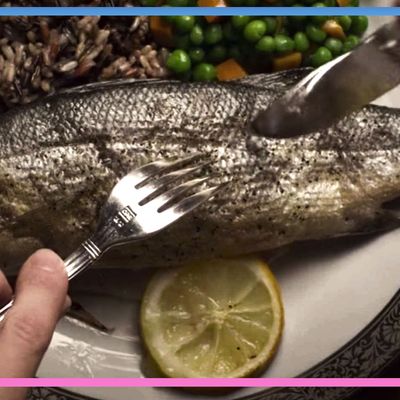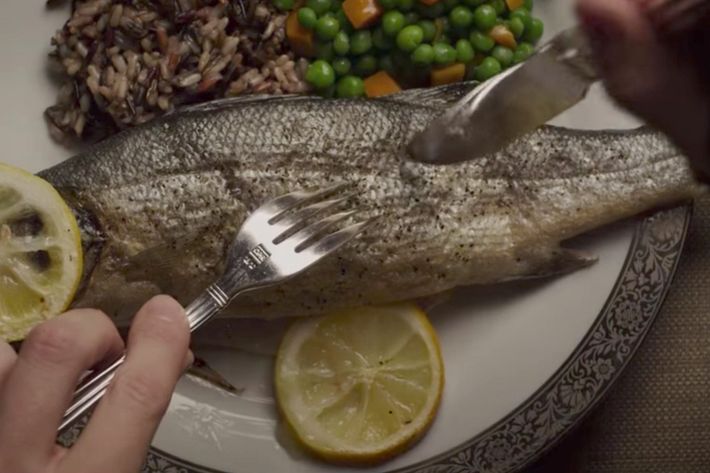
The end of the decade is drawing near, and as we begin to look back on ten years’ worth of cinematic achievements, we beg you: Spare a moment for the dinner scene in 2012’s The Amazing Spider-Man.
In what the New York Times called “the most unlikely few minutes you’ll see this year,” Andrew Garfield’s Peter Parker spends an uncomfortable supper at the posh home of crush Gwen Stacy (Emma Stone), where his fish-out-of-water status is emphasized by the fact that, as the Gray Lady recalled, “everyone is saying ‘branzino.’” A few years later, this very site joked that the movie featured “what seemed like 16 separate references to the European sea bass.” But while researching the scene this past summer, I learned a shocking truth — it turns out the word “branzino” is only spoken aloud four times in The Amazing Spider-Man. (Three times by Gwen, once by Peter.) So why does the fish loom so large in viewers’ memories?
Part of it is undoubtedly because the name “branzino” is just inherently funny, but credit for the scene’s staying power must also go to the big honking close-up of the plated bass that kicks it off. And credit for that must go to the film’s food stylist, Jack White. (Not that one.)

In over 25 years as a food stylist, White has worked on almost 100 projects, creating some of the most famous meals of modern cinema. He helped Thomas Keller make the eggy BLT from Spanglish, commonly regarded as the world’s greatest sandwich. He styled the dessert with the eyeball inside in Sam Raimi’s Drag Me to Hell, and the whimsical dishes in The Cat in the Hat. He cooked lobster pasta for Tina Fey on Date Night and baked a cake for Katherine Hepburn on Love Affair. He also spent three seasons working closely with Holly Hunter on TNT’s Saving Grace. “Her character ate almost every episode, and there was no middleman,” he recalls. “She’d be like, ‘Jack, what are we having today?’”
Like many others who find themselves working behind the scenes in Hollywood, White’s path was born out of a youthful dream of stardom. A garrulous southerner with an easy laugh, he had a stint doing dinner theater on a riverboat, as well as a run on Guiding Light in the ’80s, before moving to L.A. to further his acting career. He knew how to cook, so to pay the bills he took a gig at a friend’s catering company and wound up meeting a woman who worked as a food stylist in the industry. He’d never known such a job existed, but being on set is being on set, so he helped her make the food on 1991’s Bugsy, and things went from there.
Like everything else in town, food styling is a relationship business. Food stylists are traditionally hired by prop masters, and White happened to get in with a few prop guys who would go on to become really big. His first big break was on 1993’s Coneheads, where he created a mountain of waffles and bacon for Jane Curtin and Dan Aykroyd. “That was one that helped get me off the ground, so to speak,” he says. “I got lucky, met the right people, and did a good job.”
Styling a movie meal is not just about cooking an appetizing dish, though. Consider the branzino. The Spider-Man scene originally called for Peter to be unnerved by the fish’s eye staring back up at him — something that’s not possible with the real-life dish, where the eyes melt in the oven. White found himself having to painstakingly remove one eye from each raw fish, then place it back in a roasted socket. The scene also needed one of Gwen’s little brothers to expertly debone the fish for Peter, a task that had to be as easy as possible for the child actor. White took a pair of scissors and made a few tiny, imperceptible cuts that allowed the kid to pull the bone out as if he were a Michelin-starred chef. He did this for every fish, for every take, alongside cooking the entrees for everyone else’s plate, as well. Sadly, neither moment made the final cut.
“We went through about 90 branzinos in two or three days,” White says. “I became the expert in roasting fish.” What did he learn from cooking so much sea bass so close to some of Hollywood’s biggest stars? “You want to keep it ice cold, and then you want to make sure you get it up to 160 degrees. You don’t want any raw fish on the set. The last thing I’ve ever wanted is that an actor would get sick on set from eating my food. Thank God that’s never happened. You don’t work a lot after that.”
Inside the industry, White is most known for his work on the Hunger Games series, which required him to create a series of decadent Capitol feasts. On the second film, Catching Fire, he and his team of assistants created a 185-foot-long buffet table stocked with all manner of exotic dishes. They wound up working on it for three weeks. “I never really know what my job is during the scene until they’re doing the first take,” White says. “Actors make choices: whether they eat or don’t eat, whether they stop at a certain point that’s got bites out of it or they eat the whole thing. You’ve always got to match what they’ve done.”
If food is meant to be eaten during a scene, a stylist works with the prop master, and if not, they work with the set dresser — but the food usually has to be edible either way. (“When there’s 400 extras, and you tell them not to touch something, they’re going to eat all day long regardless,” White says.) The Hunger Games buffet was a blend. Some of the food was fake, but a lot of it was real, made from a stock kept in a huge refrigerator truck on set.
“There was so much we had to do, and it just took forever,” White says of the buffet. “And I went to see the movie, and you see it for two seconds. I cried for two days — Oh my god, why did I do all that work?”
A happier trial came on the following year’s August: Osage County. A pivotal scene in the film takes place during a knock-down, drag-out family dinner, a feat of endurance not just for the actors sitting at the table, but also the man in charge of setting it. “That sequence took five days to film, 12 hours a day, with ten actors sitting at that table, and the food changing every hour and a half,” White recalls. “They shot the scene in sequence, so we’d shoot the first page and a half, and then once they got around the table into everyone’s closeups and over-the-shoulders, then they’d move on.” Whatever state each plate was in at the end of each chunk of the scene, White would have to re-create it exactly for the next series of shots. “That was a big challenge, but a lot of fun.”
White has also occasionally enjoyed the opportunity to act in films alongside his culinary creations. For a scene in Iron Man 2, he got to serve Sam Rockwell the meal he’d cooked on camera. A dedicated improviser, the actor started talking to him during takes and by the end of the day he’d become Rockwell’s character’s assistant, who was also named Jack. The role wound up shooting for an additional week. “I was doing all the food on the movie too at the same time,” White says. “The first day I was running over between takes, getting the plates ready.” The experience wound up being an illuminating illustration of Hollywood’s unspoken social strata. “I would show up on set, and they’d ask me if I was acting that day. I’d go, ‘Yes, I am,’ and they’d go, ‘Okay Jack, leave your car here, a PA will drive you to your trailer and they’ll have breakfast for you.’ Then if I’d show up another day and say, ‘I’m a food stylist for the day,’ it’d be, ‘Get your truck in here, get it unloaded, and get the hell off the set.’ I’m like, My days change, don’t they!”
White returned to the South part-time to work on the Hunger Games movies, enlisting local culinary students to work as his apprentices. As he got older, he grew sick of living in Los Angeles, and eventually moved to Florence, Alabama, across the river from Muscle Shoals. He still does food styling for productions based in Atlanta, and he’s also opened a restaurant, Jack’s Place Bistro. One of its walls has posters from all the movies he’s worked on. He enjoys looking back.
“As a small-town kid from Pulaski, Tennessee, you never think that you’re going to be standing on set handing Katharine Hepburn a cake you made,” he says. “Then you’re going to hand her that same cake 15 times. Those moments in my life, I just pinch myself and go, How the hell did I get here?”
If you are a food stylist who has a great story to share, let us know at stories@vulture.com.





